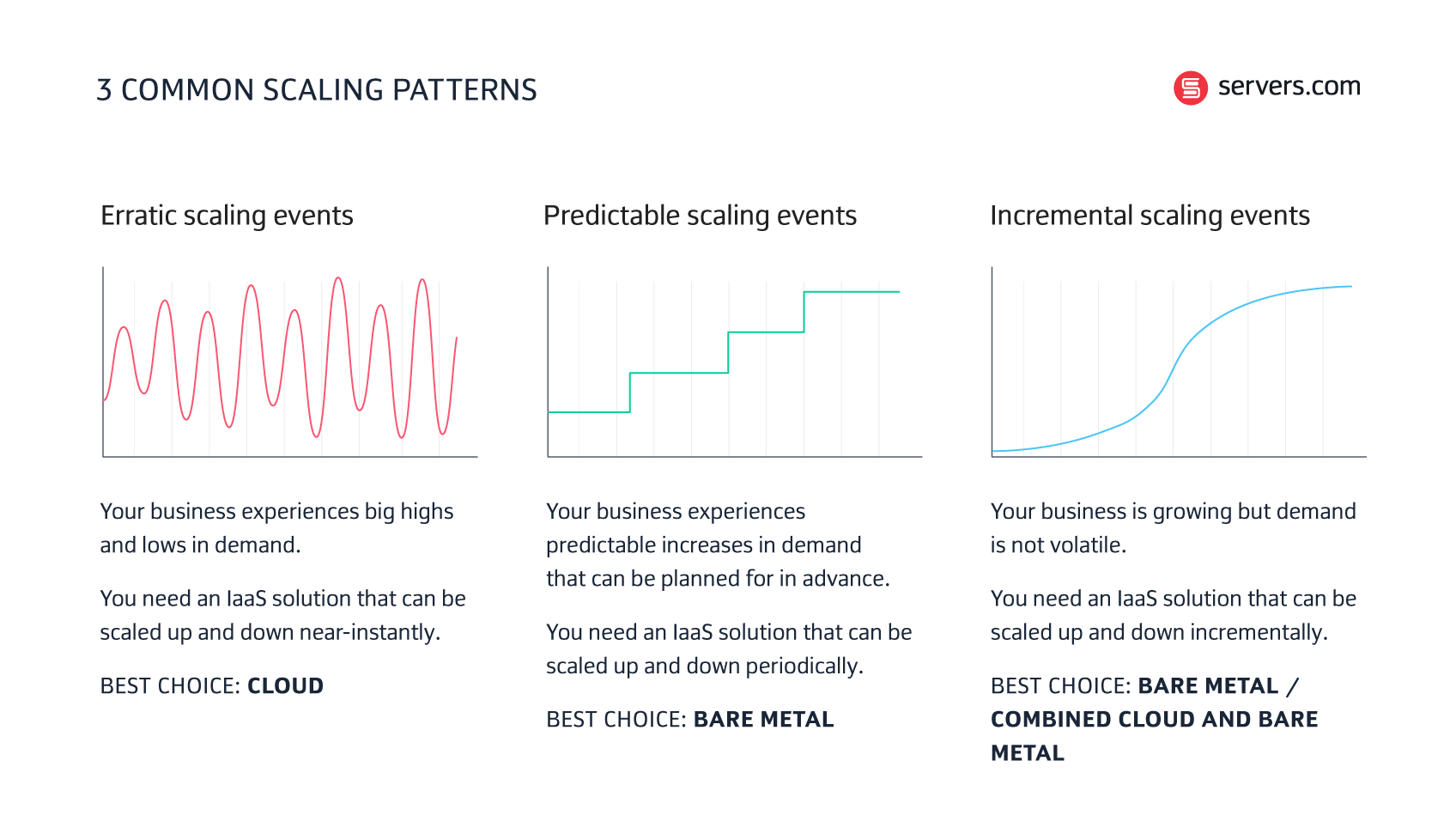

When it comes to infrastructure, finding the right balance between cost and scalability can be challenging. Many businesses don’t fully understand their own infrastructure scalability requirements or have a long-term plan for cost optimization.
And these blind spots are resulting in problematic over or under-spending.
But, as we discuss in this blog, affordability and scalability are not mutually exclusive.
Once you understand your scaling needs and the type of Infrastructure as a Service (IaaS) providers that best suits these patterns, you’ll be better equipped to provision effectively and optimize costs; to find that sweet spot between price and scalability.
Let’s take a look at how to strike that balance, avoid overspending, and the green flags to look for from IaaS providers.
There are three ways to host physical infrastructure – on-premise, colocation, and Infrastructure as a Service.
For some, the unmatched performance that comes with self-managing your infrastructure is worth the financial outlay and resources required. But for many, the management overheads are simply too high.
Two common roadblocks typically occur when organizations try to self-manage their hosting:
There are always going to be inefficiencies when you’re not executing at scale. Even large organizations can struggle to manage infrastructure in-house in a way that’s cost and resource efficient.
You’ll need a large team of in-house administrators, network engineers, DevOps professionals, and more. Having a 24/7 team managing your infrastructure is a full-time job for at least eight people and having all these people on call is expensive.
When infrastructure isn’t your sole business purpose, these inefficiencies are largely unavoidable - and you’re probably not going to achieve 24/7 coverage.
Scaling to new locations is also notoriously difficult on-prem (unless you’re planning to open a new office in that location). Those that do choose to open a new location will need to pre-purchase infrastructure and set up a data centre with capacity for a few years of growth. This is expensive and the risk of overprovisioning and overspending is high.
Inefficiency is also a common problem for organizations managing their infrastructure in colocation. Scaling in colocation can be slow. Especially if you’re trying to buy hardware direct from a technology provider.
As a result, when signing a contract with a colocation provider you might find that you have to over-provision (e.g., ordering 10 racks when you only need 5). That’s because, unless you’re able to take out a Right of First Refusal (ROFR) for adjacent racks in the data center, there’s a significant risk that those spaces will have already been taken by other customers by the time you decide you want to scale up.
This situation often pushes businesses to make snap decisions to purchase additional racks so as not to lose out in future (even if they’re not needed at that point in time).
IaaS is designed to reduce these inefficiencies and the associated management overheads by allowing organizations to reallocate infrastructure-based responsibilities to the IaaS provider. In other words, IaaS removes the burden of self-managing your hosting.
Once an organization chooses to make the switch from on-prem or colocation to IaaS, they no longer need to act as a hosting company. IaaS frees the organization up to focus on what they really are and what really matters to them.
It’s not quite as simple as choosing any IaaS provider. Choosing the right IaaS vendor model is equally important when it comes to balancing IaaS cost and scalability.
The main distinction here lies between cloud and bare metal.
IaaS scalability has become synonymous with cloud. Infrastructure as a service solutions from hyperscale cloud providers are designed to scale near-instantly by following your daily usage curve. AWS auto-scaling being the prime example. This feature continuously monitors an application and automatically increases resource capacity around demand spikes. It’s a fantastic feature – but comes at a cost.
For large-scale organizations with erratic peaks and troughs in demand, paying a premium for auto scaling is usually worthwhile. But most businesses don’t experience anything close to these major highs and lows. Yet, due to a lack of understanding about realistic scaling requirements, many still believe that they need to pay a premium for instant scalability. Even though incremental scaling is perfectly sufficient.
The result? Paying cloud IaaS costs even when it’s not required.
Infrastructure solutions that are designed to scale incrementally offer a balance between IaaS cost and scalability. Bare metal server providers offer flexible, incremental scaling that helps businesses maintain performance whilst improving profit margins. In turn supporting long-term business continuity.
For some, the best way to balance IaaS cost and scalability is to architect a hybrid approach – with a base layer of dedicated servers and a top up of cloud for any unexpected demand spikes. Using this approach allows businesses to avoid over-reliance (and over-spending) on cloud whilst ensuring that scalability requirements are fully met.
Key to choosing the right IaaS model is to understand the type of scalability events your business experiences. This can be challenging as data can only get you so far. Nobody has a crystal ball and it’s impossible to predict scaling events with 100% accuracy.
But despite the challenges, there are steps you can take to get a better handle on your scaling requirements.
The best place to start is to try and understand the pattern that your scaling events take.
Below are some examples of common scaling patterns:

To determine your scaling pattern and the type of IaaS scalability your business needs, start by asking yourself the following questions:
What causes a scaling event for my business?
How often do scaling events typically occur?
What causes downturns in demand for my business?
How often do downturns in demand typically occur?
It’s all about finding IaaS providers that don’t expect a 100% share of your wallet. Good vendors should be open to customers finding alternative sources of compute. After all, even the biggest cloud providers run out of compute from time to time.
Prioritize working with IaaS providers that take an active interest in learning about the key drivers and scenarios causing scaling events in your business. Your vendor should care about the pain that running out of compute would cause your business.
For many larger providers this is simply not a priority so it’s wise to avoid complete reliance on these vendors. If you’re married to one provider without alternative contracts and relationships in place, then you’re going to make life difficult for yourself.
Another top tip is to avoid customizing your infrastructure stack away from your providers’ core offerings too much. This just reduces your options and increases the amount of time it takes for your vendor to deploy additional servers in the case of a scaling event.

Frances is proficient in taking complex information and turning it into engaging, digestible content that readers can enjoy. Whether it's a detailed report or a point-of-view piece, she loves using language to inform, entertain and provide value to readers.